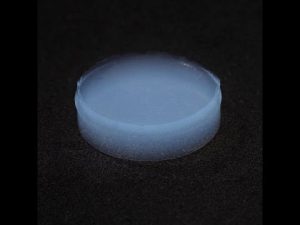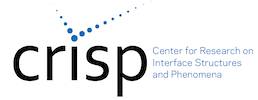Our kits are currently being reviewed and updated by a team of collaborative, innovative and interdisciplinary educators who wish to enhance the educational opportunities for students. These dedicated teachers are members of CRISP Collaborative Science for All (CCSA) as well as local educators.
Click to see the SCSU CRISP Module Template used by CCSA for improving and updating the CRISP demos and kits. Each kit page offers a CRISP developed teacher module and CRISP aligned standards (both NGSS and CCSS)
Kit Request form

Aerogel, also known as “Frozen Smoke”, is a truly space-age material, with the lowest bulk density of any known solid on Earth. Silica aerogel contains particles of 2 to 5 nm in diameter. It is 99% air, but exhibits extraordinary insulation and structural properties, and therefore holds 15 entries in the Guinness Book of Records. You can light a gas torch on one side and it won’t get hot enough to light a match sitting on the other side!
Created by CRISP adapted from materials found at teachengineering.org
Subject(s):
Properties of materials
Objectives:
Students will learn:
- Students will investigate the structural properties and applications of aerogels.
- The difference between hydrophilicity/hydrophobicity
- Why aerogel is a good material for oil spill cleanup applications
Materials in this kit:
- Vegetable oil
- Plastic spoon
- 100 cc of millimeter-sized silica aerogel particles (Lumira® LA1000)
- 1 four-color box of liquid food dye (dropper style)
- soap, water and paper towels for cleanup
- laser pen
- Small squares of aerogel
Suggestions for the Teacher:
- Please handle the aerogels gently, they are easily broken and/or damaged
Things to talk about: (Show students the aerogel photographs on slide)
- By looking at these pictures, does anyone have any ideas about what some aerogel properties might be?
- Do you think aerogels are heavy or light?
- Do you think that aerogels are strong or do you think they break easily?
Safety:
- Wash hands immediately after handling the aerogels
- DO NOT ingest aerogels
Additional Resources:
Aerogels Teacher Module
Aerogels presentation from teachengineering.org
Aerogels in Action worksheet
Aerogels in Action worksheet answers
Can aerogels help clean up toxic spills
Aerogels CRISP aligned standards
The Amazing Aerogel
Aerogels in Action
STEM Careers:
Aerospace Engineer
Environmental Technician
Manufacturing Technician
Materials Scientist
Researcher
Conservation Scientists
Environmental Scientists
Health and Safety Engineers
Industrial Engineering Technicians
Industrial Engineering Technologist
Materials Engineers
Standards:
5-PS1- 1- Develop a model to describe that matter is made of particles too small to be seen
MS-ETS1- 1 - Engineering Design
- Define the criteria and constraints of a design problem with sufficient precision to ensure a successful solution, taking into account relevant scientific principles and potential impacts on people and the natural environment that may limit possible solutions.
HS-ETS1- 1 Engineering Design
- Analyze a major global challenge to specify qualitative and quantitative criteria and constraints for solutions that account for societal needs and wants.
Interdependence of Science, Engineering, and Technology
- All human activity draws on natural resources and has both short and long-term consequences, positive as well as negative, for the health of people and the natural environment. (MS)
- The uses of technologies and limitations on their use are driven by individual or societal needs, desires, and values; by the findings of scientific research; and by differences in such factors as climate, natural resources, and economic conditions. (MS)
- New technologies can have deep impacts on society and the environment, including some that were not anticipated. Analysis of costs and benefits is a critical aspect of decisions about technology. (HS)
MS - ETS1.A: Defining and Delimiting Engineering Problems
- The more precisely a design task’s criteria and constraints can be defined, the more likely it is that the designed solution will be successful. Specification of constraints includes consideration of scientific principles and other relevant knowledge that are likely to limit possible solutions.
HS - ETS1.A: Defining and Delimiting Engineering Problems
- Criteria and constraints also include satisfying any requirements set by society, such as taking issues of risk mitigation into account, and they should be quantified to the extent possible and stated in such a way that one can tell if a given design meets them.
- Humanity faces major global challenges today, such as the need for supplies of clean water and food or for energy sources that minimize pollution, which can be addressed through engineering. These global challenges also may have manifestations in local communities.
SEP 1 - Asking Questions and Defining Problems
- Define a design problem that can be solved through the development of an object, tool, process or system and includes multiple criteria and constraints, including scientific knowledge that may limit possible solutions.(MS)
- Analyze complex real-world problems by specifying criteria and constraints for successful solutions.(HS)
SEP 2 – Developing and Using Models
- Use models to describe phenomena.
